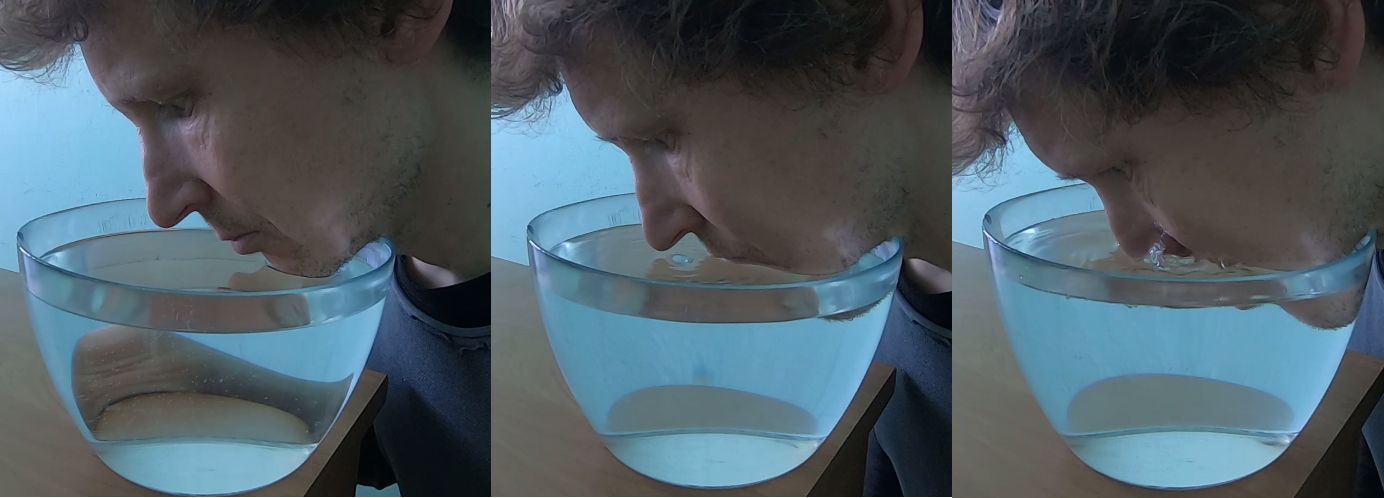5 Swimming Tips
Tip #5: Focus On Exhaling
Getting All The Air You Need
A lot of people can easily walk or even run many miles but they are breathless after a single lap. "Does swimming require some special fitness?" they wonder.
Fortunatelly it does not. If you are fit enough to walk a mile, you should be capable of swimming easily 200 m.
Virtually every beginner experiences panic when they start with swimming. That's because we can't breathe under water. And since the air is crucial for our survival, we instinctivelly hold our heads high where the air is.
But when we do it, our legs and trunk start to sink. This is what we wanted to avoid!
The fears and struggles we feel in our first attemps to swim can be deeply stored in our subconsiousness. They affect our swimming and breathing for many years later. That's why we are breathless after a short time in water.
The good news is that we can learn to breathe more efficiently and comfortably.
How To Breathe Efficiently And Comfortably
1. Don't Hold Your Breath
As soon as your head is under water, start exhaling. Slowly, fluently and through your nose.
When I teach live classes, I can very often see that people inhale, but they don't exhale. Our instincts tell us that we can breathe under water so we keep the air in.
But it is not helpful, it does not work that way. We need to regularly exchange inbreath and outbreath.
That might seem like a paradox but to have all the air you need you have to get rid of it. You have to let go.

You can try it now. Inhale and hold your breath for 10-20 s. Not longer, it can be quite uncomfortable. After a short while you can feel a tension in your chest, pulsing in your head and overall tension. How was it for you?
For some people it is more comfortable to start exhaling after a short pause. This is ok, but the pause should not be too long.
Test what best suits you right now. Inhale and:
- start exhaling immediatelly
- take a 1-2 s pause and exhale
2. Exhale strong
Breathing into water brings a unique complication: you meet a resistance from water pressure while exhaling. Especially for beginners this might be a big challenge. Get ready for this and know that the exhale has to be much stronger than you are used to when breathing outside the water.
Exhaling should be deliberate and energetic action. When you exhale sufficiently, the inhale happens almost on it own as air goes into vacuum created in your lungs.
As you roll to air, exhale forcefully. This will help you to blow away the water that might be blocking your mouth and nose.
3. Inhale just enough
Do not try to fully inhale - nor exhale. Your breathing should be very similar as you normaly breathe. However keep in mind that exhale takes much longer than inhale. So don't rush the exhaling - exhale slowly and fluently.
It is similar to a singer holding a note, then taking a short inhale.

4. Practice at home
You can improve your breathing even at home. All you need is just a big bowl filled with warm water.
- Start with only chin in the water. The rest of your face is above. Stay there for 10-20 breaths and observe how you feel. If you notice any tension, release it and keep breathing - calmly and through you nose.
- Next, submerge your mouth; nose is still above. Breathe and look at the bubbles you create with your breathing.
- Now inhale, start exhaling, and put your nose into the water. Keep your jaw relaxed, mouth shut and exhale through your nose. Again, slowly and gently. Gradually prolong the time of your exhaling. Stay calm and relaxed all the time.

Watch the video how I practiced the 3 steps from above. Can you do it with the same ease and relaxation?
All 5 Tips:
Tip #1: Hanging head
Tip #2: Patient leading arm
Tip #3: Glide
Tip #4: Power from the core
Tip #5: Emphasize the exhale (now reading)
Short of having a chance for a live coaching, the best way to master all the skills is to follow video Freestyle Mini-Course. Now for introductory price (80% off).
Join a private Facebook Group and connect with other like-minded swimmers:
